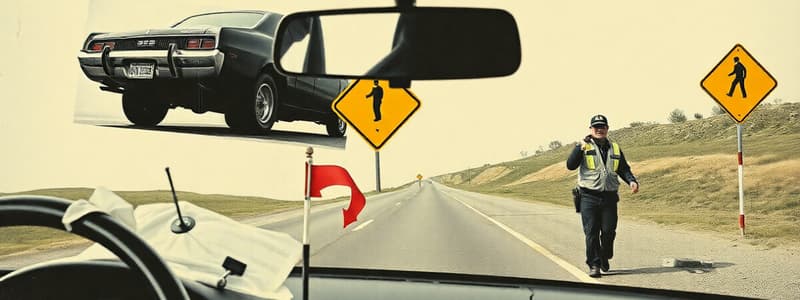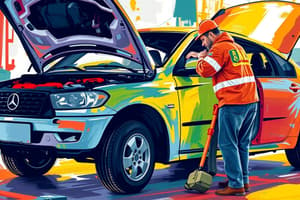Podcast
Questions and Answers
What should you do when you see fluid on the road?
What should you do when you see fluid on the road?
- Accelerate to maintain speed
- Slow down and avoid driving through it (correct)
- Make a sudden turn to avoid it
- Ignore it if other cars are behind you
What is the recommended action when you cannot avoid striking a pothole?
What is the recommended action when you cannot avoid striking a pothole?
- Brake hard just before impact
- Strike it head-on
- Steer sharply to the left
- Try to hit it at a slight angle with free rolling tires (correct)
What should you NOT do if your vehicle's tires roll off a paved surface onto an unpaved surface?
What should you NOT do if your vehicle's tires roll off a paved surface onto an unpaved surface?
- Decelerate and steer straight
- Wait until you have regained traction
- Abruptly turn the steering wheel (correct)
- Firmly grip the wheel
Which of these surface types should you practice driving on to understand vehicle response?
Which of these surface types should you practice driving on to understand vehicle response?
Which weather condition is most likely to affect vehicle performance in Florida?
Which weather condition is most likely to affect vehicle performance in Florida?
Why is it important to avoid driving through standing water?
Why is it important to avoid driving through standing water?
How does rain impact vehicle braking systems?
How does rain impact vehicle braking systems?
What should you do when driving in foggy conditions?
What should you do when driving in foggy conditions?
What effect can a small amount of rain have on driving conditions?
What effect can a small amount of rain have on driving conditions?
Why is it essential to understand how weather affects vehicle performance?
Why is it essential to understand how weather affects vehicle performance?
What should an officer always control while driving in emergency mode?
What should an officer always control while driving in emergency mode?
Which of the following is a possible psychological effect of responding to an emergency call?
Which of the following is a possible psychological effect of responding to an emergency call?
What is a physiological effect that may occur during emergency mode operation?
What is a physiological effect that may occur during emergency mode operation?
When must an officer make decisions about the use of emergency lights?
When must an officer make decisions about the use of emergency lights?
What must officers ensure at intersections while driving in emergency mode?
What must officers ensure at intersections while driving in emergency mode?
What should you do with your left hand while performing shuffle steering?
What should you do with your left hand while performing shuffle steering?
What is the primary benefit of the shuffle steering technique?
What is the primary benefit of the shuffle steering technique?
Why might motorists not hear the siren when an officer is responding to an emergency call?
Why might motorists not hear the siren when an officer is responding to an emergency call?
What happens when the caster effect occurs?
What happens when the caster effect occurs?
Which of the following is NOT a step in proper braking technique?
Which of the following is NOT a step in proper braking technique?
Why is optical driving important?
Why is optical driving important?
What is the correct way to apply the brake pedal?
What is the correct way to apply the brake pedal?
What is the role of the anti-lock braking system (ABS)?
What is the role of the anti-lock braking system (ABS)?
What must you avoid when using the shuffle steering technique?
What must you avoid when using the shuffle steering technique?
How should you prepare for a stop using proper braking technique?
How should you prepare for a stop using proper braking technique?
What is indicated by the term 'eye-targeting' in driving?
What is indicated by the term 'eye-targeting' in driving?
What is one primary reason for conducting a vehicle inspection in a law enforcement setting?
What is one primary reason for conducting a vehicle inspection in a law enforcement setting?
Which aspect of driving is emphasized for officers in the lesson?
Which aspect of driving is emphasized for officers in the lesson?
What is a common requirement for officers regarding vehicle inspections?
What is a common requirement for officers regarding vehicle inspections?
When should a vehicle inspection be conducted according to the guidelines?
When should a vehicle inspection be conducted according to the guidelines?
What may happen if an officer fails to conduct proper vehicle inspections?
What may happen if an officer fails to conduct proper vehicle inspections?
What is a potential action an agency may require if equipment fails during an inspection?
What is a potential action an agency may require if equipment fails during an inspection?
Why is it critical for law enforcement officers to understand a vehicle's limits?
Why is it critical for law enforcement officers to understand a vehicle's limits?
Which of the following is not typically included in a vehicle inspection?
Which of the following is not typically included in a vehicle inspection?
What might be a responsibility of the officer if certain vehicle problems are identified?
What might be a responsibility of the officer if certain vehicle problems are identified?
What is the correct speed to maintain when approaching a turn?
What is the correct speed to maintain when approaching a turn?
Which action should be taken immediately before entering a turn?
Which action should be taken immediately before entering a turn?
What is the purpose of looking through the turn?
What is the purpose of looking through the turn?
Which technique is recommended for steering during a turn?
Which technique is recommended for steering during a turn?
What should be used to assist visibility while backing up?
What should be used to assist visibility while backing up?
What is a key safety consideration when backing up a vehicle?
What is a key safety consideration when backing up a vehicle?
How should the vehicle be positioned before entering a turn?
How should the vehicle be positioned before entering a turn?
What effect does steering input have when driving in reverse?
What effect does steering input have when driving in reverse?
Which of the following is a common cause of law enforcement vehicle crashes?
Which of the following is a common cause of law enforcement vehicle crashes?
What should be done with the vehicle’s transmission before backing up?
What should be done with the vehicle’s transmission before backing up?
Flashcards are hidden until you start studying
Study Notes
Vehicle Inspection
- Inspecting a vehicle before using it is crucial, especially for law enforcement vehicles, which might face extreme conditions.
- Exterior Inspection: Look for potential problems like fluid leaks, damage, or unusual wear and tear on tires and lights.
- Under the Hood Inspection: Check fluid levels, hoses, electrical wiring, belts, and general engine condition.
- Interior Inspection: Inspect the interior for damage, cleanliness, and proper functionality of equipment like radio, lights, and emergency equipment.
Driving Safely on Different Surfaces
- Different road surfaces affect how vehicles handle, including concrete, asphalt, clay, dirt, gravel, sand, or brick roadways.
- Practice driving on each surface to understand how your vehicle reacts.
Weather and Vehicle Performance
- In Florida, officers should be prepared to drive in rain, fog, wind, and extremely bright sunshine.
- Rain can reduce traction, leading to skids and hydroplaning.
- Wind can affect vehicle stability, especially when passing large vehicles or driving in open areas.
Braking Techniques
- Proper braking involves applying increasing pressure to the brake pedal to stop the vehicle in the shortest distance.
- Rotate your right foot from the accelerator to the brake, keeping your heel on the floor.
Cornering
- Entry: Drive straight toward the turn, maintain a safe speed, and signal before turning.
- Apex: This is the path of travel through the turn.
- Weight Transfer: Maintain a constant speed to ensure smooth weight transfer.
- Exit: Accelerate smoothly as you exit the turn.
Backing Up
- Safety: Backing up is dangerous and can cause collisions - use side mirrors or backup cameras.
- Slow Speed: Back up slowly to compensate for reduced visibility and decreased braking efficiency.
- Steering: Use less steering to produce a larger change in direction.
- Steering Input: Large, quick steering movements while backing can lead to loss of control.
- Brakes: Ensure that brakes are adequately functional in reverse.
Driving in Emergency Mode
- Control: Always maintain control of the vehicle using proper steering, braking, and acceleration techniques.
- Psychological Stress: Emergency responses can cause stress, leading to overexertion, risky driving decisions, and tunnel vision.
- Physiological Effects: Increased heart rate, time distortion, and loss of fine motor skills can affect driving abilities.
- Emergency Equipment: Use all available emergency equipment properly to ensure a safe response.
- Siren Usage: Remember that sirens alone may not be enough to be heard by other drivers.
- Approaching Intersections: yield or stop as needed to avoid collisions while requesting right-of-way.
- Due Regard: Always act with "due regard" for the safety of others, even when responding to emergencies.
Studying That Suits You
Use AI to generate personalized quizzes and flashcards to suit your learning preferences.




